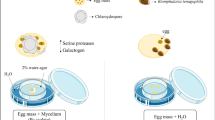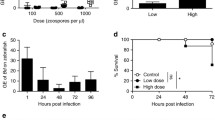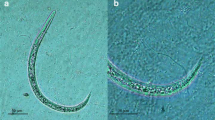Abstract
Many amphibians are known to suffer embryonic die-offs as a consequence of Saprolegnia infections; however, little is known about the action mechanisms of Saprolegnia and the host–pathogen relationships. In this study, we have isolated and characterized the species of Saprolegnia responsible for infections of embryos of natterjack toad (Bufo calamita) and Western spadefoot toad (Pelobates cultripes) in mountainous areas of Central Spain. We also assessed the influence of the developmental stage within the embryonic period on the susceptibility to the Saprolegnia species identified. Only one strain of Saprolegnia was isolated from B. calamita and identified as S. diclina. For P. cultripes, both S. diclina and S. ferax were identified. Healthy embryos of both amphibian species suffered increased mortality rates when exposed to the Saprolegnia strains isolated from individuals of the same population. Embryonic developmental stage was crucial in determining the sensitivity of embryos to Saprolegnia infection. The mortalities of P. cultripes and B. calamita embryos exposed at Gosner stages 15 (rotation) and 19 (heart beating) were almost total 72 h after challenge with Saprolegnia, while those exposed at stage 12 (late gastrula) showed no significant effects at that time. This is the first study to demonstrate the role of embryonic development on the sensitivity of amphibians to Saprolegnia.

Similar content being viewed by others
References
Bangyeekhun E, Pylkkö P, Vennerström P, Kuronen H, Cerenius L (2003) Prevalence of a single fish-pathogenic Saprolegnia sp. clone in Finland and Sweden. Dis Aquat Org 53:47–53
Banks B, Beebee TJC (1988) Reproductive success of natterjack toads Bufo calamita in two contrasting habitats. J Anim Ecol 57:472–492
Beattie RC, Aston RJ, Milner AGP (1991) A field study of fertilization and development in the common frog Rana temporaria with particular reference to acidity and temperature. J Appl Ecol 28:346–357
Blaustein AR, Hokit DG, O’Hara RK, Holt RA (1994) Pathogenic fungus contributes to amphibian losses in the pacific northwest. Biol Conserv 67:251–254
Bosch J, Martínez-Solano I, García-París M (2001) Evidence of a chytrid fungus infection involved in the decline of common midwife toad (Alytes obstetricans) in protected areas of central Spain. Biol Conserv 97:331–337
Bragg AN (1958) Parasitism of spadefoot tadpoles by Saprolegnia. Herpetologica 14:34
Bragg AN (1962) Saprolegnia on tadpoles again in Oklahoma. Southwest Nat 7:79–80
Cerenius L, Söderhäll K (1985) Repeated zoospore emergence as a possible adaptation to parasitism in Aphanomyces. Exp Mycol 9:259–263
Daszak P (1998) A new fungal disease associated with amphibian population declines: recent research put into perspective. Herpetol Bull 65:38–41
Daszak P, Cunningham AA, Hyatt AD (2003) Infectious disease and amphibian population declines. Divers Distrib 9(2):141–150
Densmore CL, Green DV (2007) Diseases of amphibians. ILAR J 48(3):235–254
Diéguez-Uribeondo J, Cerenius L, Söderhäll K (1994) Repeated zoospore emergence in Saprolegnia parasitica. Mycol Res 98:810–815
Diéguez-Uribeondo J, Fregeneda-Grandes JM, Cerenius L, Pérez-Iniesta E, Aller-Gancedo JM, Tellería MT, Söderhall K, Martín MP (2007) Re-evaluation of the enigmatic species complex Saprolegnia diclina-Saprolegnia parasitica based on morphological, physiological and molecular data. Fungal Genet Biol 44:585–601
Du Pasquier L, Schwage J, Flanjnik MF (1989) The immune system of Xenopus. Annu Rev Immunol 7:251–275
Fernández-Benéitez MJ, Ortiz-Santaliestra ME, Lizana M, Diéguez-Uribeondo J (2008) Saprolegnia diclina: another species responsible for the emergent disease “Saprolegnia infection” in amphibians. FEMS Microbiol Lett 279:23–29
Ghiasi M, Khosravi AR, Soltani M, Binaii M, Shokri H, Tootian Z, Rostamibashman M, Ebrahimzademousavi H (2010) Characterization of Saprolegnia isolates from Persian sturgeon (Acipencer persicus) eggs based on physiological and molecular data. J Mycol Med 20:1–7
Gomez-Mestre I, Touchon JC, Saccoccio VL, Warkentin KM (2008) Genetic variation in pathogen-induced early hatching of toad embryos. J Evol Biol 21:791–800
Gomez-Mestre I, Touchon JC, Warkentin KM (2006) Amphibian embryo and parental defenses and a larval predator reduce egg mortality from water mold. Ecology 87:2570–2581
Gosner KL (1960) A simplified table for staging anuran embryos and larvae with notes on identification. Herpetologica 16:183–190
Hamdoun A, Epel D (2007) Embryo stability and vulnerability in an always changing world. Proc Natl Acad Sci USA 104(6):1745–1750
Johnson PTJ, Chase JM, Dosch KL, Hartson RB, Gross JA, Larson DJ, Sutherland DR, Carpenter SR (2007) Aquatic eutrophication promotes pathogenic infection in amphibians. Proc Natl Acad Sci USA 104:15781–15786
Karraker NE, Ruthig GR (2009) Effect of road deicing salt on the susceptibility of amphibian embryos to infection by water molds. Environ Res 109:40–45
Kaufman MR, Ikeda Y, Patton C, van Dykhuizen G, Epel D (1998) Bacterial symbionts colonize the accessory nidamental gland of the squid Loligo opalescens via horizontal transmission. Biol Bull 194(1):36–43
Ke XL, Wang JG, Gu ZM, Li M, Gong XN (2009) Morphological and molecular phylogenetic analysis of two Saprolegnia sp. (Oomycetes) isolated from silver crucian carp and zebra fish. Mycol Res 113:637–644
Kiesecker JM, Blaustein AR (1995) Synergism between UV-B radiation and a pathogen magnifies amphibian embryo mortality in nature. Proc Natl Acad Sci USA 92:11049–11052
Kiesecker JM, Blaustein AR (1999) Pathogen reverses competition between larval amphibians. Ecology 80(7):2442–2448
Kiesecker JM, Blaustein AR, Miller CL (2001) Transfer of a pathogen from fish to amphibians. Conserv Biol 15:1064–1070
Lategan MJ, Torpy FR, Gibson LF (2004) Biocontrol of saprolegniosis in silver perch Bidyanus bidyanus (Mitchell) by Aeromonas media strain A199. Aquaculture 235:77–88
Martín MP, Raidl S, Tellería MT (2004) Molecular analysis confirm the relationship between Stephanospora caroticolor and Lidtneria trachyspora. Mycotaxon 90:133–140
Ortiz-Santaliestra ME, Marco A, Fernández MJ, Lizana M (2006) Influence of developmental stage on sensitivity to ammonium nitrate of aquatic stages of amphibians. Environ Toxicol Chem 25:105–111
Ovaska K, Davis TM, Novales I (1997) Hatching success and larval survival of the frogs Hyla regilla and Rana aurora under ambient and artificially enhanced solar ultraviolet radiation. Can J Zool 75:1081–1088
Poorten TJ, Kuhn RE (2009) Maternal transfer of antibodies to eggs in Xenopus laevis. Dev Comp Immunol 33:171–175
Puglis HJ, Boone MD (2007) Effects of a fertilizer, an insecticide, and a pathogenic fungus on hatching and survival of bullfrog (Rana catesbeiana) tadpoles. Environ Toxicol Chem 26(10):2198–2201
Rachowicz LJ, Hero JM, Alford RA, Taylor JW, Morgan JAT, Vredenburg VT, Collins JP, Briggs CJ (2005) The novel and endemic pathogen hypotheses: competing explanations for the origin of emerging infectious diseases of wildlife. Conserv Biol 19:1441–1448
Romansic JM, Diez KA, Higashi EM, Blaustein AR (2006) Effects of nitrate and the pathogenic water mold Saprolegnia on the survival of amphibian larvae. Dis Aquat Organ 68(3):235–243
Romansic JM, Higashi EM, Diez KA, Blaustein AR (2007) Susceptibility of newly-metamorphosed frogs to a pathogenic water mould (Saprolegnia sp.). Herpetol J 17(3):161–166
Romansic JM, Diez KA, Higashi EM, Johnson JE, Blaustein AR (2009) Effects of the pathogenic water mold Saprolegnia ferax on survival of amphibian larvae. Dis Aquat Organ 83(3):187–193
Ruthig G (2009) Water molds of the genera Saprolegnia and Leptolegnia are pathogenic to the North American frogs Rana catesbeiana and Pseudacris crucifer, respectively. Dis Aquat Organ 84:173–178
Sagvik J, Uller T, Stenlund T, Olsson M (2008a) Intraspecific variation in resistance of frog eggs to fungal infection. Evol Ecol 22:193–201
Sagvik J, Uller T, Olsson M (2008b) A genetic component of resistance to fungal infection in frog embryos. Proc R Soc B 275:1393–1396
Smith MA, Berrill M, Kapron CM (2002) Photolyase activity of the embryo and the ultraviolet absorbance of embryo jelly for several Ontario amphibian species. Can J Zool 80:1109–1116
van West (2006) Saprolegnia parasitica, an oomycete pathogen with a fishy appetite: new challenges for an old problem. Mycologist 20:99–104
Walls SC, Jaeger RG (1987) Aggression and exploitation as mechanisms of competition in larval salamanders. Can J Zool 65:2938–2944
White TJ, Bruns T, Lee S, Taylor JW (1990) Amplification and direct sequencing of fungal ribosomal RNA genes for phylogenetics. In: Innis MA, Gelfand DH, Sninsky JJ, White TJ (eds) PCR protocols: a guide to methods and applications. Academic, San Diego, pp 315–322
Willoughby LG (1978) Saprolegnias of salmonid fish in Windermere: a critical analysis. J Fish Dis 1:51–67
Yamasaki H, Katagiri C, Yoshizaki N (1990) Selective degradation of specific components of fertilization coat and differentiation of hatching gland cells during the two phase hatching of Bufo japonicus embryos. Dev Growth Differ 32:65–72
Zaror L, Collado L, Bohle H, Landskron E, Montaña J, Avedaño F (2004) Saprolegnia parasitica in salmon and trout from southern Chile. Arch Med Vet 36:71–78
Acknowledgments
Funding was provided by the Spanish Ministry of Education and Science (refs. CGL2005-03727 and Flora Micológica Ibérica VI, CGL2006-12732-C02-01), and by the Diputación de Ávila (Inst. Gran Duque de Alba). The Castilla y León Regional Government provided permission for egg collection and the experimental procedures.
Author information
Authors and Affiliations
Corresponding author
Additional information
Communicated by Craig Osenberg.
Rights and permissions
About this article
Cite this article
Fernández-Benéitez, M.J., Ortiz-Santaliestra, M.E., Lizana, M. et al. Differences in susceptibility to Saprolegnia infections among embryonic stages of two anuran species. Oecologia 165, 819–826 (2011). https://doi.org/10.1007/s00442-010-1889-5
Received:
Accepted:
Published:
Issue Date:
DOI: https://doi.org/10.1007/s00442-010-1889-5




